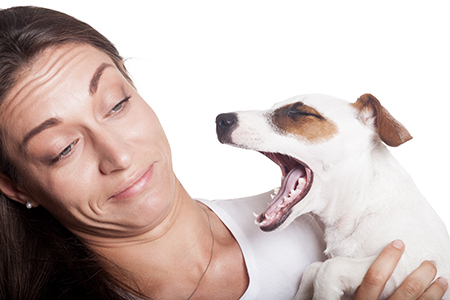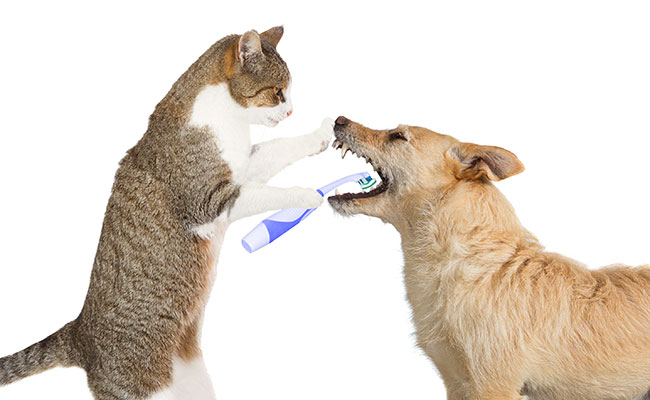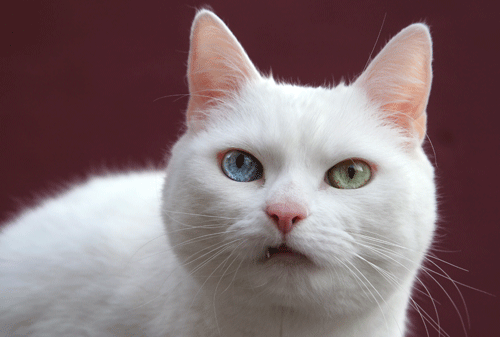 Dental disease in pets is the most common problem for both dogs and cats. While that is a true fact, it doesn’t need to be a problem with your furry friends. With just a little planned prevention, your pet can lead a long and happy dental life. No doggy or cat dentures for them!
Dental disease in pets is the most common problem for both dogs and cats. While that is a true fact, it doesn’t need to be a problem with your furry friends. With just a little planned prevention, your pet can lead a long and happy dental life. No doggy or cat dentures for them!
What is Dental Disease in Pets?
Dental disease in pets is one of the most common maladies seen by veterinarians. It is estimated that over two-thirds of all dogs and cats over the age of three are estimated to have some form of periodontal or dental disease. In a dog, periodontal disease (inflammation or infection of the gums around the teeth) is the most common indicator of dental disease, with tooth decay constituting less than 10% of dental problems. The problem is that few pets show obvious signs of dental disease, and they certainly can’t just speak up and say “Hey owner, I have a toothache”. So the responsibility falls on the pet’s family and Dr. Whitworth at Whitworth Animal Clinic to uncover this silent and usually painful veterinary dentistry condition. The progression of gum disease is as follows:
• Bacteria found naturally in an animal’s mouth multiply and form plaque on the teeth. Some plaque is removed naturally by chewing and the animal’s tongue.
• Accumulation of tartar and calculus on the teeth causes inflammation and gum recession around the base of the tooth.
• Infection soon follows and the gums recede further, exposing sensitive unprotected tooth root surfaces and the bony tooth sockets
• If untreated, the infection can spread deep into the tooth socket, destroying the bone. Ultimately, the tooth loosens and falls out
Bad Breath is a Sign of Dental Disease
Bad breath in a pet is not just a reflection of the ingredients in the food your pet eats. That odor might signify a serious health risk, with the potential to damage not only your pet’s teeth and gums, but can be spread through the bloodstream to its internal organs as well, causing infections in the heart valves, kidneys and/or liver. So, give your pet something to truly smile about (and yes, pets DO smile) by making pet dental health a priority.
Prevention is the Key
As pet owners it is our responsibility to provide nutritious food, exercise, safety, love, health care and proper oral care. But so often in the rush of the daily routine, or when finances are stretched, our pet’s teeth often fall to the bottom of the priority list. But this neglect not only ends up putting a huge toll on our pet’s health, it also ends up really dinging our expenses. Year round dental care not only means a healthier pet, but overall lower out-of pocket expenses.
As with so many health issues, both animal and human, prevention for dental disease in pets is the key. Proper pet oral hygiene helps your dog and cat ward off bad breath, plaque, tartar build-up, eventual periodontal disease, and potential organ damage. Early detection of tooth, gum & oral disease will give you and your pet less of a toothache in the long run. And the earlier the problems are identified and treated, the more positive the outcome. There are two main components to preventative oral care for your pet:
◊ Routine daily teeth cleaning and brushing which only takes a few minutes out of the day. If this is not possible, two to three times a week can make a big difference in your pet’s oral health.
◊ Have your pet’s teeth examined by Dr. Whitworth at their yearly physical. He will check for signs of bad breath, accumulation of tartar, signs of gum disease and other dental problems. Dr. Whitworth will determine if a professional dental cleaning is required.
How Do I Keep My Pet’s Teeth Healthy?
• Avoid giving your pets human food, especially anything with processed carbohydrates or added sugars, since sugar can encourage bacterial growth. It’s also worth investigating some specifically formulated dental diet foods that mechanically assist in plaque removal.
• Keep tartar away while providing entertainment by giving your dog dental chews. Products approved by the Veterinary Oral Health Council (VOHC) are recommended. However, do not substitute chews for routine brushing.
• Brush your dog or cat’s teeth every day – at least every other day (but you wouldn’t brush your child’s mouth every other day would you?). Purchase a special pet toothpaste and toothbrush. Never use human toothpaste since the fluoride can be toxic to your pet’s kidneys if swallowed.
• Start the brushing routine slowly for your pet to adapt. Be gentle and use positive reinforcement because your pet may be anxious and fearful of the toothbrush, and cats can be particularly difficult to cooperate.
• Start by placing toothpaste on your fingers and gently rubbing them in your pet’s mouth to get them accustomed to the taste and feeling of rubbing on their teeth. Then you can try a toothbrush after they accept your fingers without hesitation.
It’s Time To Schedule Your Pet’s Dental Exam
Your pet will agree that the rewards of clean breath and a healthy grin is truly worth your time and effort. It’s important to check periodically for pain, swelling, redness, infection, bad breath, and/or loose or broken teeth. If your pet is having trouble chewing and swallowing then schedule a dental checkup at Whitworth Animal Clinic, located in Madison, Alabama and providing veterinary services to pets from Madison, Huntsville, and the surrounding Madison County areas, because nothing compares to a good thorough yearly cleaning by a veterinarian.
Since each pet’s circumstance is unique, and anesthesia is used for a professional cleaning in order to remove plaque and tartar below the gum line, it is recommended that you schedule a consultation with Dr. Whitworth about any specific health risks to your pet prior to the procedure. Sometimes Dr. Whitworth will prescribe an anti-biotic prior to cleaning to clear any active infections. And animals with certain heart, kidney or liver health conditions may require a pre-procedure blood panel to make sure they are strong enough to handle the anesthesia.
So, let’s see those smiles! Pet family members – get ready, set, pucker up!
For more information about pet dental disease visit the American Veterinary Medical Association website: https://www.avma.org/resources-tools/pet-owners/petcare/pet-dental-care





